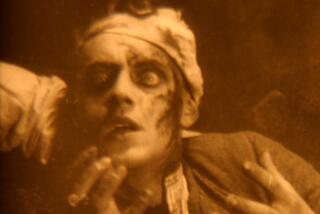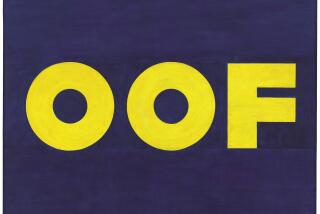The Revolutionary Returns to Favor : Art: The works of Liubov Popova, until recently a shadowy figure in Soviet art, go on display Sunday at LACMA.
- Share via
V I. Lenin died of multiple brain hemorrhages on Jan. 21, 1924, in the town of Gorky. He was 53. Less than four months later, artist Liubov Sergeevna Popova died in Moscow of scarlet fever contracted from her young son who succumbed a few days earlier. She was just 35.
Lenin and Popova probably never met but the connection is as intimate as that between an author and a character that inhabits his work.
After his return to the Finland station in 1917, Lenin forged a revolution that reverberated for most of the century. Something peculiarly Russian marked its blend of epic sweep and intimate detail. It was real history’s sequel to “War and Peace.”
Until recently, Popova was part of a lost chapter in that epic. Like Lenin she was a revolutionary whose time was too short. Unlike him she was one whose memory was for a time erased. Sunday, an exhibition surveying her work will come to the Los Angeles County Museum of Art.
It will present 55 paintings and 66 works on paper--including signature works from her “Painterly Architectonic” and “Space-Force Construction” series--plus a selection of utilitarian designs done in the direct glare of the revolution. Group exhibitions of this art date back at least a decade. Now, surveys devoted to its individual masters begin to appear. A new book on Popova throws welcome light, but frustrating obscurity remains. The art itself was suppressed as if its maker never existed.
But how does one become, simply, erased? In revolutionary Russia it was quite simple. Joseph Stalin won Lenin’s emptied place. Victorious, he could decide many things such as who lived, who died and--incidentally--what would and would not be art.
The sort of abstraction practiced by Popova and her comrades from Malevich to Rodchenko and Tatlin was rendered invisible.
By the time Popova’s art was sent to the Siberia of storerooms, she had already been dead for a decade. Maybe in terms of a mordant relativity she was lucky to die with Lenin.
In the beginning, it seemed that the story of Liubov Popova was going to be written by Anton Chekhov. She was born April 24, 1889, and grew up on an estate outside Moscow. Her family was rich and cultivated. (Liubov’s scholar brother, Pavel, married Tolstoy’s granddaughter.)
Liubov had an uncommonly broad liberal-arts education. Eventually, she would see at least one of the great private collections of modern art being formed by adventurous Russian merchants who traveled to Paris, men like Ivan Morozov and Sergei Shchukin. They collected everything from Cezanne to Matisse and Picasso. Young Russian artists formed a Cezanne-influenced group called Jack of Diamonds. It became the cradle of artistic radicalism in Russia. Popova showed with the group.
And she traveled. In Italy, she loved Giotto and the rationality of Renaissance architecture. In 1912 and 1914, she sojourned to Paris with girlfriends and it was there that the dozen years of her mature work began. She studied with Jean Metzinger and Henri Le Fauconnier and was influenced by their second-wave Cubist styles. She visited the studios of Ossip Zadkine and Alexander Archipenko.
In Moscow in the fall of 1913 she could have seen leading revolutionary poet Vladimir Mayakovsky acting his own play “A Tragedy.” But in Paris she could read Proust and listen to Stravinsky. It must have suited her better. Friends described her as courageous, straightforward and outspoken. One praised her for having a “good figure, marvelous eyes and luxuriant hair.” Said to possess a magnetic personality, she had a capacity for dropping past attachments.
On Aug. 1, 1914, Germany declared war on Russia. Russians out of the country scrambled to get home. Sergei Prokofiev hurried back from London. Wassily Kandinsky waited until November to leave Germany. Popova was not so tardy.
One of humankind’s most common reactions to cataclysmic events is to carry on normally. Popova painted in earnest in a new style influenced by Malevich. She’d started a salon for left-leaning intellectuals. Among them was Boris von Eding, an art historian and expert on ancient Russian architecture. Russians love dialectical disputation. Put any four of them together and you will get eight manifestoes. Or so they say.
By January, 1917, endurance and self-deception must have been wearing thin. Temperatures were at 40 degrees below zero. Railroads were paralyzed, cities were cut off from food and supplies. The Romanov dynasty fell. Bolsheviks stormed the Winter Palace but the angry mob that invaded the former czar’s residence was so awed by its opulence they left it unmolested.
A typhus epidemic erupted. The disease would kill 3 million. Through the persistence of paradox, this was the epidemic that caused the young Armand Hammer to go to Russia with an offer of medical assistance. That led to a friendship with Lenin, an eventual fortune for Hammer, a private museum for his art collections and a Malevich exhibition in Los Angeles. The same epidemic would have consequences for Popova.
In March, 1918, the Bolsheviks withdrew from the “capitalist-imperialist” war and Popova married Von Eding. In November, they had a son. In the summer of 1919, they sojourned to Rostov-on-the-Don. While out of town, Von Eding contracted typhus and died. Popova was infected. By the time she returned to Novinsky Boulevard she had a serious heart condition. She did not work steadily again until 1921.
When she resumed she was transformed into a relentless worker, comrade and organizer fighting for the new order through her art.
So far, writings on avant-garde artists and the communist regime have characterized the relationship as mutually enthusiastic, which may be less than precise. The revolution had, after all rather forced the artists’ hand. Their professional infrastructure disappeared. No more commercial art market. The Shchukin and Morozov collections were nationalized and the collectors went into exile--something Russians are particularly loathe to do.
Popova, like other members of her class, certainly had mixed feelings. Revolution ended a comfortable life but signaled participation in a great human experiment. Marxism--so it was believed--had discovered scientific laws of history and economics that would change the world. Cultivated Russians who had long felt sophisticated Europe thought them backward would now be in the advanced guard on all fronts.
Revolution ignited every shade of human reaction. Some artists behaved like saints, others were unsavory opportunists who betrayed friends and ideals. Some simply left. But at first, for artists already primed by aesthetic radicalism, it must have seemed utopia was coming. It was not.
A disastrous drought in 1920 became a famine that killed another 3 million. Despite all this, the bureaucracy established state art schools. The new government promoted artists to apparatchiks. From Malevich to Chagall they were appointed to posts with ponderous titles. Popova, among other things, established the design course for Vkhutemas (Higher State Artistic and Technical Studios). It was to train artists for industrial production.
She pitched in with a vengeance, making art despite severe shortages of materials, writing stiffly impassioned theoretical formulations justifying the practical application of art to the revolution. Behind it all one senses a desperate need to make sense of a private world destroyed by social upheaval and personal tragedy.
Some time after the death of her husband, the authorship of Popova’s life had passed from Chekov to some grotesque combination of the Keystone Kops and Franz Kafka. Formerly independent artists suddenly found their lives utterly uprooted and their fates in the hands of ruthless technocrats.
Russians survived the revolution through the exercise of guile, forbearance and an almost boundless capacity for irony. Maxim Gorky played along with Lenin, using his influence at least to help those writers he favored.
Popova and her ilk mixed some measure of sarcastic mental reservation with their revolutionary fervor. Her most successful works of the Constructivist period were her 1922 designs for the play “The Magnanimous Cuckold.” Working with Russia’s leading theatrical director, Vsevolod Emilievich Meierkhold, she produced a set that looks like Suprematist Dada. Full of senseless gears and meandering platforms, it predicted Chaplin’s classic, “Modern Times.” Yet Popova did not shirk to work with Meierkhold on “Earth on End,” an unabashed piece of revolutionary propaganda. The trouble, of course, was that the party was out to form a totalitarian empire while the artists limned the idealistic dream behind it--equality, brotherhood of man, the unification of the arts in the service of the people. Their dramatic abstract style was the perfect paradigm of distilled ideology. But like any accurate art, it could be interpreted as much as a critique as a celebration.
In the end, the Soviets couldn’t stand that kind of insight. In the end it is lucky for art that evil cannot bear the look of it.
When Popova died, her comrades praised her as a “confirmed atheist and materialist.”
It was a compliment.
More to Read
The biggest entertainment stories
Get our big stories about Hollywood, film, television, music, arts, culture and more right in your inbox as soon as they publish.
You may occasionally receive promotional content from the Los Angeles Times.










